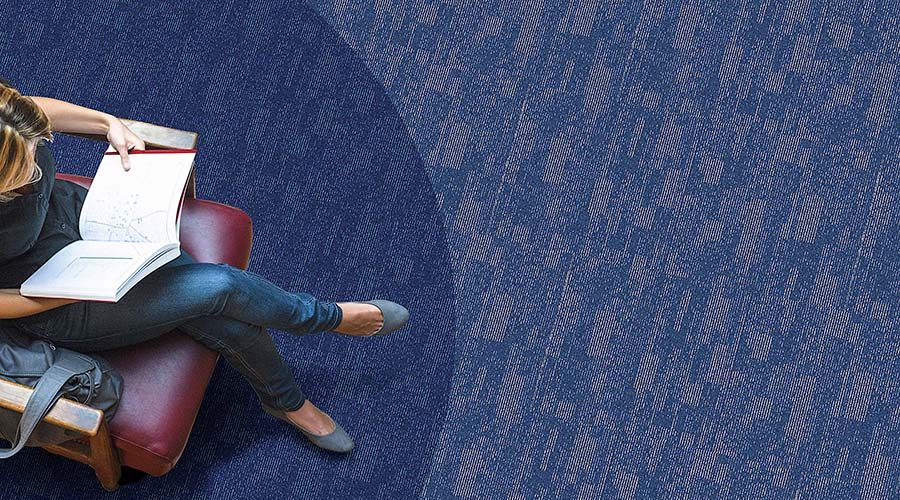In this article, Paragon Carpet Tiles discusses how flooring can be used to promote safe social distancing within public sector spaces.
Paragon
It is more important than ever for spaces to be COVID-secure. Safety should be the number one priority for any business, as just one badly-organised space can risk the spread of the virus.
Renovation is a great long-term solution to pandemic-proof a space, to help the public stay protected. Interior design and flooring can be used to keep a space clean and help enforce safe social distancing.
Commercial and public spaces must adapt to ensure that people are safeguarded against coronavirus. In such unpredictable times, architects, contractors, local authorities and heads of sites must work to transform a space to adhere to the latest Government guidelines.
Floorless social distancing
To adhere to Government guidelines, measures must be introduced to help space users keep a safe distance from one another. As well as overt signage which conveys important messages, discreet ways to mark out areas are also favourable.
Changing the placement of furniture, for example desks and seating, is one of the easiest ways that people can be kept apart. A safe distance can be measured and kept between each piece of furniture to prevent physical contact with other households.
However, this is often not enough, as furniture can be accidentally shifted and moved by users out of the safe measurements put in place. When people come to move around the space, that’s when problems start to occur. Therefore, more permanent, heavy-duty solutions are needed.
Studies show that pedestrian flow systems can effectively help to assist in the fight against coronavirus and reduce contact between individuals. Flooring is a great way to reinforce one-way systems and can help better direct people in and around buildings.
Our Guide carpet tile range provides clear instructions for the public to keep a safe distance from one another and wayfind, whilst still seamlessly blending into existing flooring designs. With instructions and messages incorporated into the tiles, this design will not fade over time.
Carpet is one of the safest flooring types
Commercial spaces, especially in the public sector, must be kept incredibly hygienic to stop the spread of germs and bacteria. If an environment does not meet the high standards required and becomes a hotspot for coronavirus, there is a real risk that it could cause an outbreak.
As handwashing is the first line of defence against coronavirus, hand sanitisation points are a necessity within any building. However, keeping up with stringent hygiene does not solely lie with the users of a space. Businesses need to take extra measures to make sure spaces are clean and meet hygiene standards.
According to The New England Journal of Medicine, coronavirus can live on non-porous surfaces such as plastic and laminate for up to 72 hours. Therefore, these materials are probably not the best to use when renovating a space, as they can increase the risk of coronavirus spreading from person to person.
The latest research suggests that porous surfaces, like carpet, are less hospitable to the virus, as cold and flu viruses survive for a much shorter time on these materials. This means that carpet is one of the safest and most hygienic flooring solutions on the market.
Cleaning of visibly dirty surfaces followed by disinfection is the best way to neutralise COVID-19, according to the Centers for Disease Control and Prevention. All of our high-quality carpet tiles are able to withstand the strict cleaning measures needed to maintain a high level of sanitation, without ruining or fading.
Safe, stylish and effective solutions
Social distancing is of paramount importance in limiting the spread of coronavirus. However, people can find it easy to forget the rules in a space they find familiar. Therefore, people must be constantly reminded of the regulations in place.
Whilst barriers and hazard tape are a quick fix, these are a short-term solution. Hazard tape can peel away after just a few short days and increase the risk of trips and falls within a space. However, there are subtle and certainly more stylish ways to promote social distancing – using carpet tiles.
For example, laying carpet tiles in a large square pattern on the floor can help create zones, borders and demarcation areas. Using bright, vibrant colours against more subtle tones can make zones more visible in public sector environments, whilst also keeping them looking stylish.
The carpet tiles in our Guide range can be easily lifted up and moved, meaning that installers can make changes to the layout when the pandemic is over or when building design changes. Messaging can also be used to complement this technique, to direct people to these zones and remind them to stay apart from one another.









